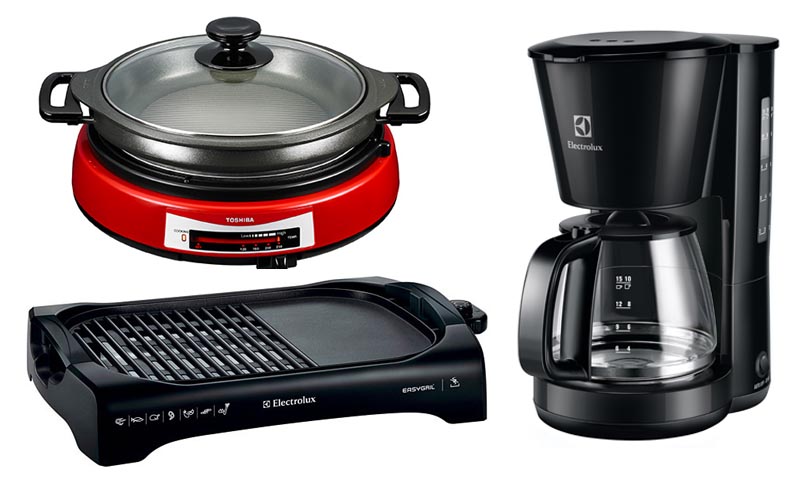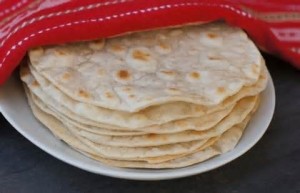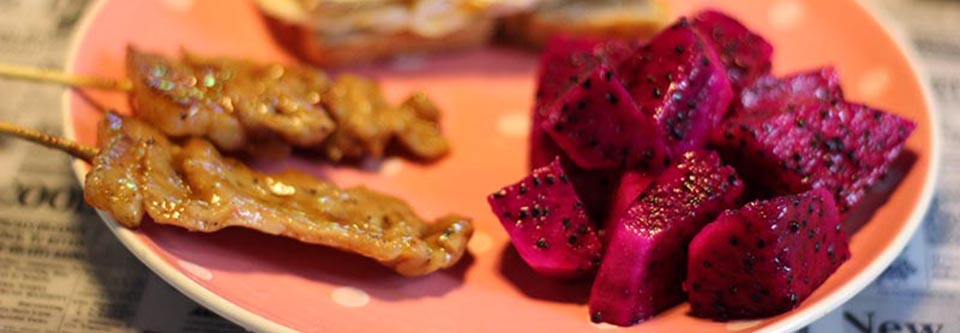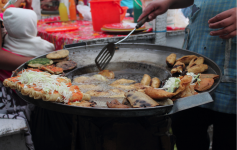When asked for the one tip that they would give to anybody thinking of following in their footsteps, expats continually answer, “Flexibility.” Ain’t that the truth!! And nowhere is that more evident than in the kitchen!
The amount of changes you will have to make in the culinary aspects of your life will be dependent on where you live. Here in Thailand, if you have the money, it is possible to live almost entirely a western lifestyle, including buying or renting a place with a fully outfitted western kitchen complete with a large oven and stovetop. Head off to the closest, well-stocked grocery store and you will be able to find most of the ingredients and foods that you are accustomed to at home. However, this kind of shopping and eating will soon deplete your budget in a foreign country just as living on imported food items will be outrageously expensive in your home country.

Over the last few years of living in China, and now Thailand, we have learned how to cope! I love to cook and end up doing most of it. For six years, I have experimented and learned a few tricks that I will share with you here. Although we are now in Thailand, much of what I say here will apply more to places where western food is more difficult to find and/or create since I came up with most of these ideas while surviving in our Chinese kitchen.
I will say at the beginning that the easiest way to survive in another country is to eat the same stuff and cook the same way as the locals. But damn it, some times we just have a hankering to chow down on some tasty western food without heading for the nearest expensive foreign restaurant, which don’t even exist in many places you will find yourself. And, in many cases, you can make your own better version of what you will find while eating out.
So without further adieu, here is my rambling about surviving with only the kitchen sink! Whether you cook western meals or try to integrate the local cuisine into your life, it can be a challenge. I have also included links to some of my recipes along the way
Living without an oven!
For the most part, ovens do not exist in Asia. Stuff is barbequed, stir-fried, deep fried, boiled or steamed. Or eaten raw! Kitchens are usually tiny and have very few cooking appliances. You are not going to find the plethora of energy guzzling amenities that populate the average North American household. The largest “oven” in Wuhan most of us could purchase was much larger than an average toaster oven but could easily fit into a normal Western oven that we all know and cherish. You could use it to bake one tray at a time of your latest recipe. They were great for one-dish items but cooking a couple of dozen cookies took awhile!
However, the good news is that you can do a lot of the same stuff in a rice cooker, which is available in most places you will find yourself. If you are lucky, you will be able to find a crockpot or slow cooker but a rice cooker will basically do the same thing. There are oodles of recipes available online for cooking almost anything in one of these things.

Stovetop baking! Ok, so you can’t produce a two-layer chocolate cake on a burner but you can easily make treats such as chocolate chip cookies without an oven. The secret is that the heat must be very, very low or they will burn quickly. It will take some experimenting but it only took me a couple of batches to learn how low a setting to use for my appliance that is a cross between an electric frying pan and a wok. Since we have moved to Thailand, I have used this technique for biscuits and enchiladas, as well. I think it would be difficult to do this on a gas burner but is easily manageable in any electric appliance where the heat can be adjusted to a very low setting.
And finally, almost every place you live will probably have a microwave which everyone has experience in using. It’s an easy habit to get into but you’ll sacrifice quality and taste if you start relying on microwaving everything. Although they are certainly great for reheating yesterday’s leftovers, making popcorn and cranking out 5-minute chocolate cake.
Where’s the beef?
There is an obsession with beef in North America. In much of Asia, buying a little ground beef or a large roast is an expensive proposition. No worries! For most recipes, it just doesn’t matter. Here, pork and chicken reign supreme. Wherever you find yourself, use whatever meat is available. Buy it like the locals and cook it the way you want. You may end up with a whole chicken from the market or a chunk of pork that could be from any part of the animal. In many places, cuts of meat as we have in Canada and the US do not exist. However, you don’t need a prime rib or t-bone if you are slow cooking it on the stovetop or in a rice cooker.
You will soon learn where and how to find great tasting protein! By the time you add onion, peppers, and spices, the ground meat you choose for that burger is irrelevant! And if you can’t find any hamburger buns, make some large biscuits to use as a replacement. I have also realized that it is possible to get away with using much less meat in most recipes than is called for. Many traditional Thai recipes call for 100g or less of meat (unless you find them in a Western cookbook!).
Fish is rampant across Asia. It didn’t take us long to realize we had to get to it before they chop it up into a zillion pieces. Filleting is an unknown concept here. Most vendors just steam or barbeque it and then take the cleaver to it until they have bite sized pieces. Buy fresh fish, take it home and cook it yourself.
Cook from scratch!
This is really the secret to being able to recreate many of your favorite foods from home or duplicate the local dishes. For a lot of people, this is a scary proposition! They are used to heading off to the nearest grocery store and picking up a box of pancake mix or can of soup. Many things are not that difficult to make. If you lead a really busy life, spend some time making a large batch and divide it up into freezer bags.
In China, I often made pancakes for breakfast. They were quick and easy. However, finding any kind of syrup was a different problem unless we drove for an hour to the nearest large grocery store that carried a few western items. So what I used to do was head to the local corner store, buy a large box of juice, add some sugar and boil it down to a fruit syrup. That gave me the opportunity to make any kind of topping I wanted! Of course, you could do the same thing with fresh fruit, but there comes a point where it is more trouble than it is worth!
Salads, fruit smoothies, sandwiches…these are all easy items to concoct with local ingredients that can have a western or local flair, depending on what you use.
Don’t cook from scratch!
I just had to do that! There are times when cooking from scratch is just plain not worth it. When we first moved to Thailand, I was really excited to start making Thai recipes with all the local veggies, herbs and spices that surround us here in our neighbourhood. I still had my trusty little recipe book that I received at a Thai cooking course I attended while we were on holiday one year and now I finally had my chance to shine.
Within the first few day, I walked over to the corner market and returned with galangal root, chili peppers, Kafir limes, and a host of other ingredients. I took out my brand new, handcrafted wooden mortar and pestle and started smashing everything into a nice paste. To make a long story short, let’s just say that I ended up with enough authentic Thai red chili paste for awhile. I used some for dinner and froze the rest. I still had tons of fresh produce left over that I never did use and ended up eventually throwing away. Despite the romantic vision of making my own curry paste, I have since found that it is a lot easier and quicker to march over to the nearest corner store and buy a little bottle of any Thai made curry paste I want or pick up a small bag of freshly made paste from one of the many street vendors! This is why they don’t have big kitchens.
Buy cheese in bulk!
Many foreign foods are cheaper if you buy a large amount. I love Mexican food and I love cheese. Cheese that has been frozen can easily be used in cooking. In Asia, cheese can be very expensive for a very small quantity. I don’t buy the little packages. I get a whole round, cut it up into recipe sized portions, stuff it into small freezer bags and put it in the freezer. That gives me enough cheese for a very long time. If you are never going to use that much in your lifetime, go in on the purchase with a friend. Parmesan, mozzarella…you would be surprised at how much money you will save if you buy these in bulk.
What the hell do these people eat?
Obviously, the easiest way to survive is to eat and cook like the local residents. With a little research, you can easily determine what they live on and then adapt it to fit your western taste buds. You can buy the same stuff but you don’t have to cook it the same way. Of course, the major change would be to cut down on the spices for many people. We, personally, love hot food and usually end up with no feeling in our lips after a normal meal! However, that is not most people’s idea of a good feed.
Watch what people buy at the markets and grocery stores. Even if you don’t know what the heck it is (which was often the case in China), get the same stuff, take it home and blunder your way through cooking with it. You will find things you enjoy and others that you hate.
Watch the people who are preparing the various street foods and then attempt to copy them in your own kitchen. I have successfully done this on numerous occasions, not always after the first attempt! I usually come away after the ordeal with a lot more admiration for the street vendors who crank this stuff out quickly and efficiently.
Get a new-found friend to teach you how to make a few local specialties. It’s a lot easier if they help you shop for the popular local ingredients. There is nothing more difficult than trying to figure out what is in that bottle or can if there is no English anywhere to be seen. In China, we had a good friend and her mom teach us how to make Hot Dry Noodles, a Wuhan breakfast specialty. We not only learned the recipe but it was a fun experience having a traditional breakfast in a Chinese home!
Tortillas are my friends!
I am going to finish off this little posting with a word about tortillas. They have been my best friends since we moved to Asia when I want a taste of home. Ok, they are not the most Canadian food out there but they still give me a Western flavor when I feel the urge. I use them for breakfast burritos, tacos, enchiladas, fajitas, quesadillas, and just plain old wraps. Here in Thailand, good bread is everywhere. In China, it was a different story.
Once I learned how to make my own tortillas, it opened up a lot of great possibilities. If you are lucky, you can find packages of them at your local grocery store. And even when I have purchased them in a store, I have found they are often stuck together into one big mass. Hence, I started making my own. If you have the courage to try, you can use this recipe. It will take a little practice but once you learn how to make them, it is very easy to produce a couple or a couple of dozen.
Creativity is the key!
So throw away your preconceived notions! Try some new things. Shop at the local markets. Don’t expect recipes you make here to end up exactly as those at home. Mix and match your own recipes with local ones. I gave up trying to use some of the Thai rice noodles. I have yet to have any success with them and usually end up with solid mass of inseparable pasta. Now I just use western noodles to make Thai dishes. It’s a hell of a lot easier!
I rarely tried to duplicate any traditional Chinese recipes. I grabbed a bunch of veggies and pork, threw them in the wok, added some seasoning and stirred away. When I couldn’t find ready-made enchilada sauce, I just used fresh tomatoes, tomato sauce or spaghetti sauce and added a bunch of Mexican seasoning. When living in a foreign country, it is often easier and less expensive to walk out the door and grab some street food if you want to eat local fare. But if you want that good old western stuff that you crave, you are probably better off making it yourself.





Good article, Steve! We are blessed with an Indonesian daughter-in-law who makes Indo food. She and Arron live in Maple Ridge so she has access to the Asian food markets and cooks amazing food for us when we visit.
Sometime soon I’m going to ask you about blogging for money. I’m writing now I have time and am interested to know if it is worthwhile. Enjoy the warmth of Asia! Blessings!